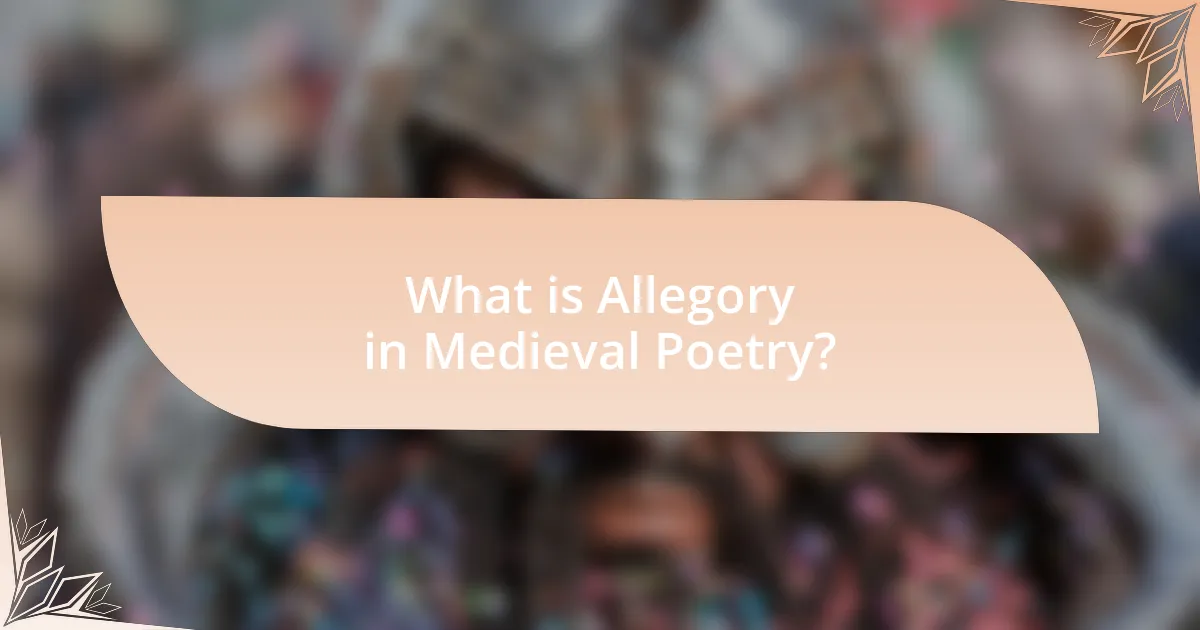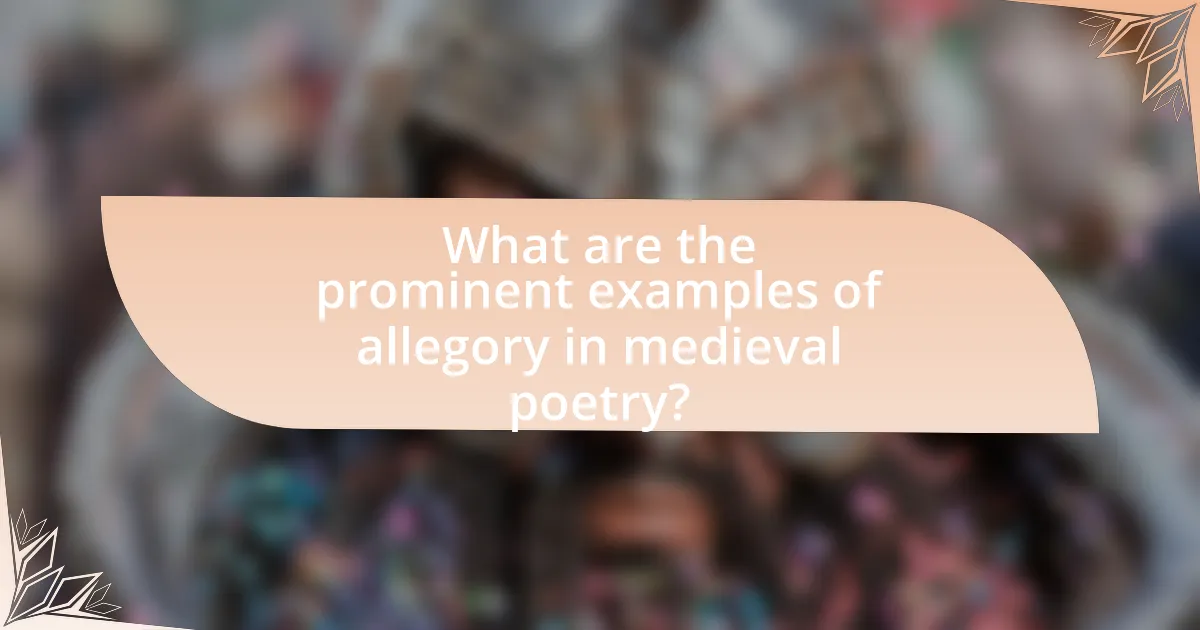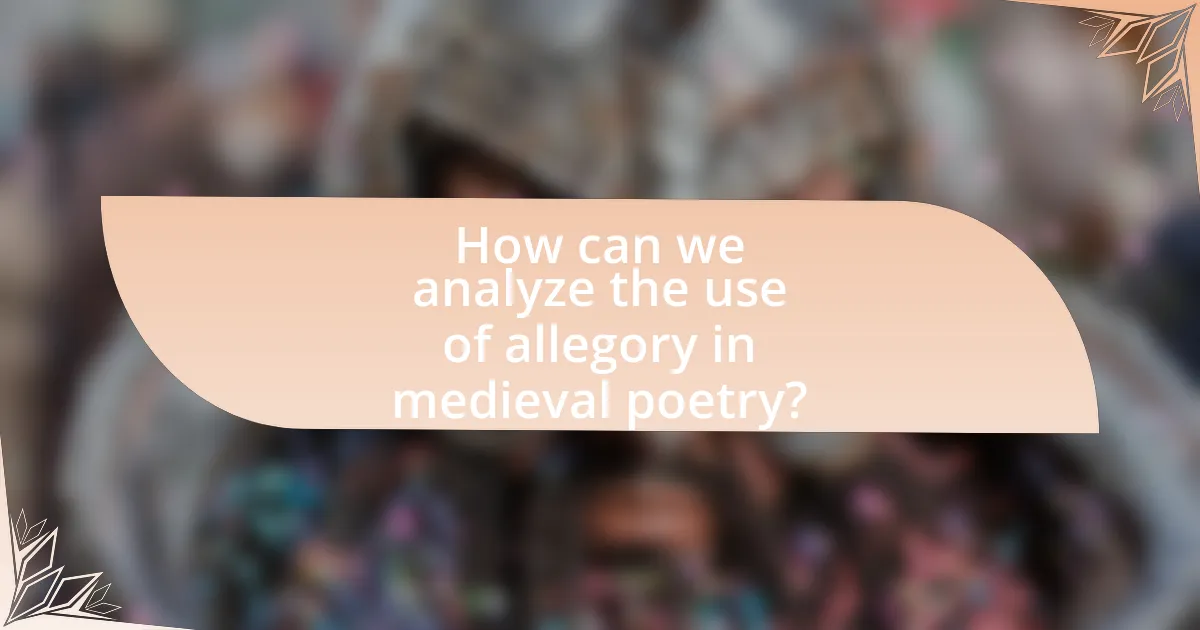Allegory in Medieval Poetry is a literary device where characters, events, and details symbolize deeper moral, spiritual, or political meanings, prevalent during the medieval period. This article explores the definition and significance of allegory in medieval literature, highlighting key characteristics and prominent examples, such as Dante Alighieri’s “Divine Comedy” and Geoffrey Chaucer’s “The Canterbury Tales.” It examines how allegory conveys complex ideas, reflects societal values, and serves religious and moral purposes, while also addressing the cultural and historical factors that influenced its use. Additionally, the article discusses methods for analyzing allegorical texts and the challenges that arise in interpretation, providing insights into the multifaceted nature of allegory in medieval poetry.

What is Allegory in Medieval Poetry?
Allegory in Medieval Poetry is a literary device where characters, events, and details symbolize deeper moral, spiritual, or political meanings. This technique was prevalent during the medieval period, allowing poets to convey complex ideas and themes through symbolic narratives. For instance, works like Dante Alighieri’s “Divine Comedy” utilize allegory to explore concepts of sin, redemption, and the human soul’s journey, illustrating how allegorical elements can reflect societal values and beliefs of the time.
How is allegory defined within the context of medieval literature?
Allegory in medieval literature is defined as a narrative technique in which characters, events, and details symbolize deeper moral, spiritual, or political meanings. This literary device was prevalent in works such as Dante Alighieri’s “Divine Comedy,” where the journey through Hell, Purgatory, and Heaven represents the soul’s path toward God. Allegory served to convey complex ideas and ethical lessons, often reflecting the religious and philosophical beliefs of the time, thereby allowing readers to engage with abstract concepts through concrete imagery and storytelling.
What are the key characteristics of allegorical poetry?
Allegorical poetry is characterized by its use of symbolic figures and actions to convey deeper moral, spiritual, or political meanings. This form of poetry often employs personification, where abstract concepts are represented as characters, allowing readers to interpret the underlying messages. Additionally, allegorical poetry typically features a narrative structure that unfolds a story with dual meanings: the literal and the allegorical. For instance, works like Dante Alighieri’s “The Divine Comedy” exemplify this characteristic by intertwining personal journey with broader themes of sin and redemption. The effectiveness of allegorical poetry lies in its ability to engage readers on multiple levels, prompting reflection on both the surface narrative and the deeper implications of the symbols used.
How does allegory differ from other literary devices in medieval poetry?
Allegory in medieval poetry differs from other literary devices by conveying complex ideas and moral lessons through symbolic figures and actions, rather than relying solely on literal descriptions or straightforward narratives. While devices like metaphor and simile create comparisons to enhance imagery, allegory operates on a deeper level, where characters and events represent abstract concepts, such as virtue, sin, or societal issues. For instance, in works like “The Divine Comedy” by Dante Alighieri, the journey through Hell, Purgatory, and Heaven serves as an allegorical representation of the soul’s journey towards God, illustrating moral and theological themes. This layered meaning distinguishes allegory from other literary devices, which may not encapsulate such extensive moral or philosophical implications.
Why was allegory significant in medieval poetry?
Allegory was significant in medieval poetry because it allowed poets to convey complex moral, spiritual, and philosophical ideas through symbolic narratives. This literary device enabled writers to address themes such as virtue, sin, and redemption in a manner that was accessible to audiences who may not have been literate or familiar with abstract concepts. For instance, works like Dante Alighieri’s “Divine Comedy” and Geoffrey Chaucer’s “The Canterbury Tales” utilized allegorical elements to explore human experiences and societal values, making profound messages relatable and engaging. The use of allegory also reflected the medieval worldview, where the intertwining of the spiritual and temporal realms was a central concern, thus reinforcing its importance in the poetic tradition of the time.
What cultural and historical factors influenced the use of allegory?
Cultural and historical factors that influenced the use of allegory include the rise of Christianity, the feudal system, and the educational reforms of the medieval period. The dominance of Christian theology provided a framework for allegorical interpretation, as many medieval poets used allegory to convey moral and spiritual lessons aligned with biblical teachings. Additionally, the feudal system shaped societal hierarchies and relationships, which were often reflected in allegorical representations of virtues and vices. Educational reforms, particularly the establishment of universities and the revival of classical texts, encouraged the use of allegory as a sophisticated literary device, allowing poets to engage with complex ideas in a manner accessible to their audiences. These factors collectively fostered an environment where allegory became a prominent tool for expression in medieval poetry.
How did allegory serve religious and moral purposes in medieval texts?
Allegory served religious and moral purposes in medieval texts by conveying complex spiritual and ethical messages through symbolic narratives. Medieval authors utilized allegory to represent abstract concepts such as virtue, sin, and redemption, making these themes accessible to a largely illiterate audience. For instance, in works like Dante Alighieri’s “Divine Comedy,” characters and events symbolize moral lessons and theological principles, guiding readers toward spiritual enlightenment. This method not only reinforced the teachings of the Church but also encouraged moral reflection among readers, as seen in the use of personified virtues and vices in texts like “Piers Plowman” by William Langland. Such allegorical representations were effective tools for moral instruction and religious education during the medieval period.

What are the prominent examples of allegory in medieval poetry?
Prominent examples of allegory in medieval poetry include “The Divine Comedy” by Dante Alighieri, “Piers Plowman” by William Langland, and “The Pearl” by an anonymous poet. “The Divine Comedy” uses the journey through Hell, Purgatory, and Heaven to represent the soul’s journey towards God, illustrating moral and theological themes. “Piers Plowman” employs allegorical figures like Lady Holy Church and Piers to explore social justice and spiritual salvation. “The Pearl” features a dream vision where the narrator converses with a symbolic figure representing his deceased daughter, addressing themes of loss and redemption. These works exemplify how medieval poets utilized allegory to convey complex moral and spiritual messages.
Which poets are known for their use of allegory?
Poets known for their use of allegory include Dante Alighieri, Geoffrey Chaucer, and John Bunyan. Dante’s “Divine Comedy” employs allegory to explore themes of morality and the soul’s journey, while Chaucer’s “The Canterbury Tales” uses allegorical characters to critique society. John Bunyan’s “The Pilgrim’s Progress” is a seminal work of allegory, depicting the spiritual journey of a character named Christian. These poets effectively utilize allegory to convey complex ideas and moral lessons through symbolic narratives.
What are the most famous allegorical works from the medieval period?
The most famous allegorical works from the medieval period include “The Divine Comedy” by Dante Alighieri, “Piers Plowman” by William Langland, and “The Pearl” by an anonymous poet. “The Divine Comedy,” written in the early 14th century, explores themes of sin, redemption, and the afterlife through a journey in the realms of Hell, Purgatory, and Paradise. “Piers Plowman,” composed in the late 14th century, uses allegory to critique social injustices and promote moral reform through the character of Piers, a Christ-like figure. “The Pearl,” a 14th-century poem, employs allegory to convey themes of loss and salvation, framed within a dream vision. These works are significant for their intricate use of allegory to address complex moral and philosophical issues of their time.
How do these works illustrate the principles of allegory?
These works illustrate the principles of allegory by using characters and events to represent abstract ideas and moral lessons. For instance, in “The Divine Comedy” by Dante Alighieri, the journey through Hell, Purgatory, and Heaven symbolizes the soul’s path toward God, embodying themes of sin, redemption, and divine justice. Similarly, in “Pearl,” the narrative structure and the character of the Pearl-Girlfriend represent the quest for spiritual enlightenment and the nature of grief, reflecting the allegorical tradition of conveying deeper truths through symbolic storytelling. These examples demonstrate how medieval poetry employs allegory to engage readers in complex moral and philosophical discussions.
What themes are commonly explored through allegory in medieval poetry?
Common themes explored through allegory in medieval poetry include morality, the nature of good and evil, and the human condition. Medieval poets often used allegory to convey complex moral lessons, illustrating virtues such as justice, temperance, and charity through personified characters and narratives. For example, in “The Divine Comedy” by Dante Alighieri, the journey through Hell, Purgatory, and Heaven serves as an allegorical representation of the soul’s journey towards God, emphasizing themes of redemption and divine justice. Similarly, in “Piers Plowman” by William Langland, allegory is employed to critique social injustices and explore the relationship between faith and works, highlighting the importance of moral integrity in achieving salvation. These examples demonstrate how allegorical elements in medieval poetry effectively communicate profound philosophical and ethical themes.
How do themes of morality and virtue manifest in allegorical poetry?
Themes of morality and virtue manifest in allegorical poetry through the representation of abstract concepts as characters or narratives that embody ethical dilemmas and moral lessons. In works like Dante Alighieri’s “Divine Comedy,” characters such as Virgil and Beatrice symbolize reason and divine love, respectively, guiding the protagonist through moral challenges and illustrating the consequences of sin and the rewards of virtue. This use of allegory allows poets to explore complex moral questions in a structured manner, making ethical teachings accessible and engaging for readers. The allegorical framework serves to reinforce the importance of moral choices, as seen in the contrasting fates of characters who embody different virtues and vices, ultimately promoting a didactic purpose in the poetry.
What role does social commentary play in these allegorical narratives?
Social commentary in allegorical narratives serves to critique societal norms and highlight moral lessons. These narratives often reflect the values, conflicts, and issues of their time, using symbolic characters and events to convey deeper meanings. For instance, in works like “The Divine Comedy” by Dante Alighieri, the allegory critiques political corruption and moral decay in medieval society, illustrating the consequences of sin and the importance of virtue. This use of social commentary not only engages readers with contemporary issues but also encourages reflection on ethical and moral dilemmas, making the narratives relevant across generations.

How can we analyze the use of allegory in medieval poetry?
To analyze the use of allegory in medieval poetry, one can examine the symbolic meanings behind characters, events, and settings within the texts. Allegory often serves to convey moral, religious, or philosophical messages, as seen in works like Dante Alighieri’s “Divine Comedy,” where the journey represents the soul’s path to God. Additionally, analyzing the historical context and the author’s intent can reveal how allegorical elements reflect societal values and beliefs of the medieval period. For instance, the use of personification in “Piers Plowman” illustrates social justice themes, making the allegorical analysis relevant to understanding the poem’s critique of contemporary issues.
What methods are effective for interpreting allegorical meanings?
Effective methods for interpreting allegorical meanings include contextual analysis, symbolic interpretation, and comparative literature. Contextual analysis involves examining the historical and cultural background of the text, which can reveal the author’s intentions and the societal issues being addressed. For instance, understanding the socio-political climate of the medieval period can provide insights into the allegories present in works like Dante’s “Divine Comedy.”
Symbolic interpretation focuses on identifying and analyzing symbols within the text, as these often carry deeper meanings. For example, in “The Pearl,” the pearl itself symbolizes purity and redemption, reflecting the protagonist’s spiritual journey.
Comparative literature allows for the exploration of similar themes across different texts, enhancing the understanding of allegorical meanings. By comparing allegorical elements in various medieval poems, scholars can identify common motifs and themes, such as the use of light and darkness to represent knowledge and ignorance.
These methods collectively enhance the interpretation of allegorical meanings, providing a richer understanding of the text’s underlying messages.
How can historical context enhance our understanding of allegorical texts?
Historical context enhances our understanding of allegorical texts by providing insights into the societal, political, and cultural influences that shaped their creation. For instance, medieval poetry often reflects the religious and moral values of the time, such as the significance of the Church and the feudal system, which can be seen in works like Dante Alighieri’s “Divine Comedy.” Understanding the historical backdrop of the 14th century, including the impact of the Black Death and the rise of humanism, allows readers to interpret the allegories more deeply, recognizing how they critique or reinforce contemporary beliefs and practices. This contextual knowledge reveals the layers of meaning embedded in the texts, making them more accessible and relevant to modern audiences.
What literary theories can be applied to the analysis of allegory?
Various literary theories can be applied to the analysis of allegory, including structuralism, post-structuralism, and psychoanalytic theory. Structuralism focuses on the underlying structures and systems of meaning within texts, allowing for a systematic interpretation of allegorical elements. Post-structuralism, on the other hand, emphasizes the instability of meaning and the multiplicity of interpretations, which is particularly relevant in allegorical works that often convey complex and layered messages. Psychoanalytic theory explores the unconscious motivations and desires represented in allegory, providing insight into character actions and symbolic meanings. These theories collectively enhance the understanding of allegory’s role and significance in literature, particularly in the context of medieval poetry, where allegorical interpretations often reflect moral, social, and philosophical themes.
What challenges arise when analyzing allegory in medieval poetry?
Analyzing allegory in medieval poetry presents several challenges, primarily due to the complexity of symbolic meanings and historical context. The multifaceted nature of allegory often leads to varied interpretations, as symbols can represent multiple ideas depending on the cultural and religious background of the audience. Additionally, the lack of contemporary references and the evolution of language over time complicate the understanding of allegorical elements. For instance, texts like “The Divine Comedy” by Dante Alighieri utilize intricate allegorical structures that require knowledge of medieval theology and philosophy to fully grasp their significance. This necessitates a careful examination of historical context, authorial intent, and audience reception to accurately interpret the allegorical messages embedded within the poetry.
How does ambiguity in allegorical interpretation affect analysis?
Ambiguity in allegorical interpretation complicates analysis by allowing multiple meanings to coexist, which can lead to varied interpretations of a text. This multiplicity can obscure the author’s intended message, making it challenging for scholars to reach a consensus on the text’s significance. For instance, in medieval poetry, allegorical elements often draw from religious, moral, and social contexts, which can be interpreted differently based on the reader’s perspective or historical background. Consequently, the lack of clarity in allegorical symbols can result in divergent analytical outcomes, as seen in works like Dante’s “Divine Comedy,” where various interpretations arise from its rich allegorical layers.
What are common misconceptions about allegory in medieval literature?
Common misconceptions about allegory in medieval literature include the belief that allegory is solely a moral or religious tool, and that it lacks complexity or depth. While many medieval texts, such as “The Divine Comedy” by Dante Alighieri, utilize allegory to convey moral lessons, they also explore intricate themes of human experience, identity, and societal critique. Additionally, some readers assume that allegorical interpretations are universally agreed upon; however, interpretations can vary significantly based on cultural and historical contexts, as seen in works like “Piers Plowman” by William Langland, which invites multiple readings. These misconceptions overlook the rich, multifaceted nature of allegory in medieval literature, which serves not only didactic purposes but also engages with the complexities of life and thought during that era.
What practical tips can enhance the analysis of allegory in medieval poetry?
To enhance the analysis of allegory in medieval poetry, readers should focus on understanding historical context, as it provides insight into the cultural and societal influences that shaped the allegorical meanings. For instance, recognizing the significance of religious themes prevalent in medieval literature can illuminate the moral and spiritual lessons embedded within the poetry. Additionally, examining the use of symbolism and metaphor within the text allows for a deeper interpretation of the allegorical elements, as these devices often serve as vehicles for conveying complex ideas. Engaging with secondary literature, such as scholarly analyses and critiques, can also offer diverse perspectives and interpretations that enrich the understanding of allegorical content.
How can readers develop a critical approach to allegorical texts?
Readers can develop a critical approach to allegorical texts by actively engaging with the symbolic meanings and contextual backgrounds of the narratives. This involves analyzing the characters, events, and settings to uncover deeper moral, social, or political messages that the author intends to convey. For instance, in medieval poetry, allegorical figures often represent abstract concepts such as virtues or vices, requiring readers to interpret these representations within the historical and cultural context of the time. By examining the historical significance of the allegory, such as the use of religious symbolism in works like Dante’s “Divine Comedy,” readers can gain insights into the societal values and beliefs of the era, thereby enhancing their understanding of the text’s critical dimensions.
What resources are available for further study of allegory in medieval poetry?
Resources available for further study of allegory in medieval poetry include academic books, journal articles, and online databases. Notable texts such as “The Allegory of Love” by C.S. Lewis provide foundational insights into allegorical interpretation, while “Medieval Allegory: The Challenge of the Text” by John M. McGalliard offers specific analyses of allegorical works. Scholarly journals like “Speculum” and “The Chaucer Review” frequently publish articles on medieval poetry and allegory, providing peer-reviewed research. Additionally, databases such as JSTOR and Project MUSE contain extensive archives of relevant literature, facilitating access to a wide range of studies on the subject.